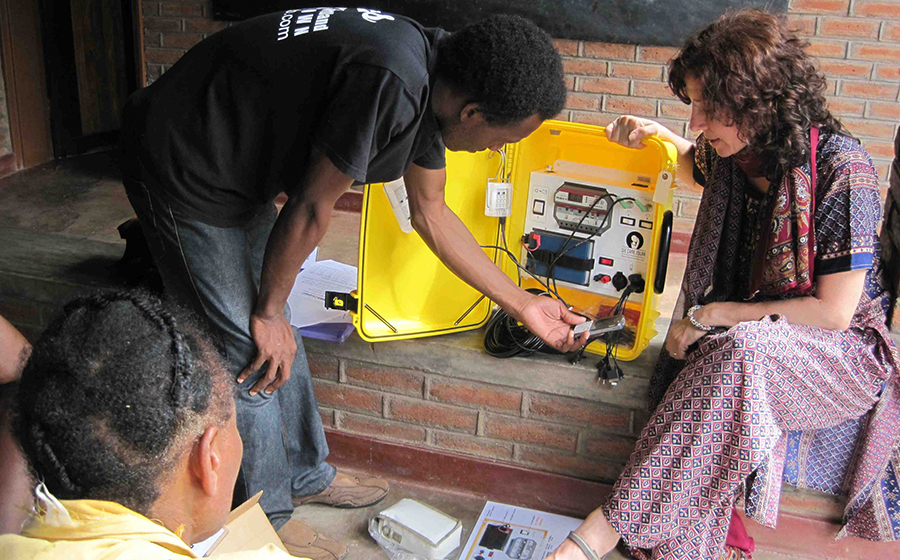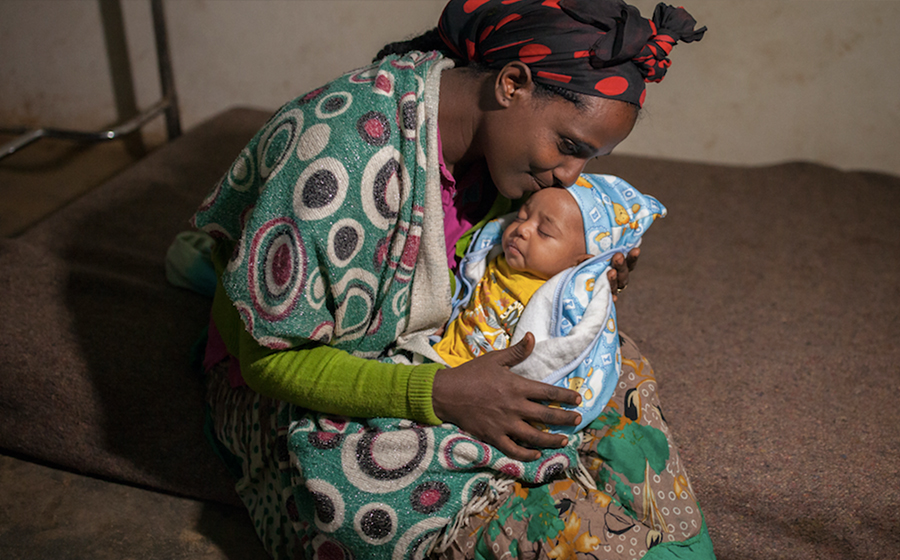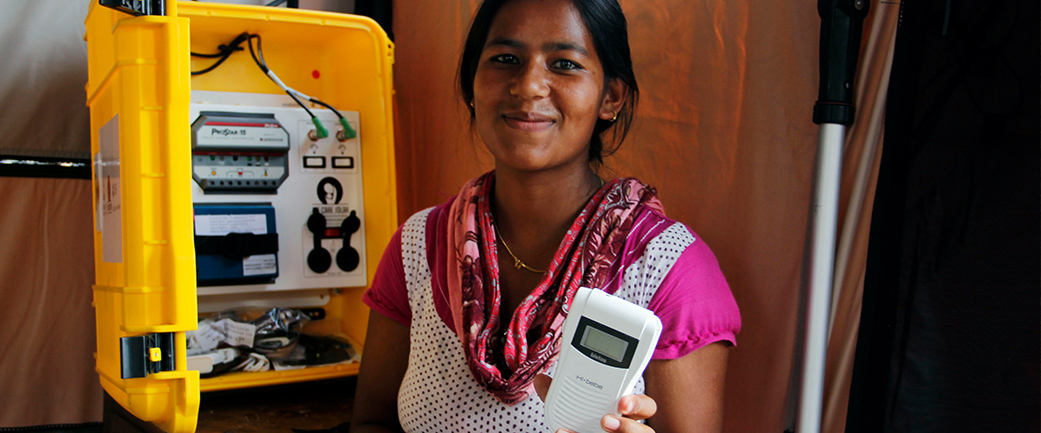
How solar power is saving the lives of mothers and newborns in Africa and Asia and being delivered to disaster zones around the world
The worker arrives with a rugged yellow plastic suitcase in hand, having made her way to a maternity hospital””or what passes for one””in one of the poorest, most remote regions in the world. When she arrives, she clicks it open to reveal an amazing invention that harnesses power from the sun in order to saves lives. The set-up includes solar panels that will be fastened to the roof, medical lights, headlamps, and a fetal Doppler. When it’s hooked up and working, the lights in the delivery room will shine throughout the night, cell phones can be charged, the baby’s heartbeat can be monitored, and the health workers can work safely, no matter the time of day, delivering babies and saving lives.
But it wasn’t always this way . . .
When Dr. Laura Stachel, an obstetrician-gynecologist from the Bay Area with a strong interest in public health, went to Africa to study why hundreds of women in the developing world die each day giving birth, she was stunned. While observing care in a Nigerian maternity hospital some years ago, she was shocked when she saw what women had to endure in regions where resources were slim or nonexistent.The hospital had frequent power outages. At night, a single kerosene lamp lit the entire maternity ward.These were horrifying conditions under normal circumstances, but life threatening during an emergency, a C-section delivery, or a more complicated birth.Women were even being turned away from hospitals due to a lack of resources.
“I literally watched as nurses turned away women who were bleeding to death, telling them that they could not be helped. I realized that women were dying in silence. Once I saw that, it was something I felt I couldn’t forget, and I couldn’t turn my back on it, “Stachel says.

Back home in Berkeley, California, Dr. Stachel shared her stories with her husband, Hal Aronson, who has his PhD in environmental sociology, and who was working on renewable energy projects in the Bay Area at the time. He designed a solar electric system that would serve the areas of the hospital critical for maternal survival: the maternity ward, delivery room, laboratory, and operating theater. He also equipped his wife with a portable demonstration solar unit that she could transport easily overseas.
When Laura brought it to Nigeria to show what solar could do, the hospital staff insisted on keeping it. “If you leave it here, you will help us save lives,” an operating room technician told her. Clearly, keeping the lights on and providing a reliable power source was a matter or life and death. Dr. Stachel left the prototype behind as she raised funds to install the larger hospital system.
Within one year of receiving solar energy, maternal deaths in the Nigerian hospital went down by seventy percent, and women were no longer being turned away at night. But surrounding clinics began asking for solar power, and a scalable solution was needed. It was at that moment that Aronson and Stachel realized they could and should produce a rugged suitcase-sized solar electric system for other facilities. As Stachel says, “All women have the right to deliver safely in clinics with reliable lighting and power.”
Word spread, and soon requests were coming from health centers beyond Nigeria. Volunteers initially assembled Solar Suitcases in Aronson and Stachel’s backyard and hand carried them to remote villages in Rwanda, Tibet, and Sierra Leone. The project continued to grow exponentially, and to keep up with demand, the suitcases are now made in factory. The nonprofit organization We Care Solar was established, and it works in partnership with international NGOs and UN agencies to build local capacity in solar installation and maintenance. An added education component teaches midwives and health workers how to use the devices.

In addition to lighting maternity wards, Solar Suitcases were used in Sierra Leone and Liberia during the Ebola crisis. Hundreds were sent to the Philippines after Typhoon Haiyan in 2013, to Nepal after their devastating earthquake in 2015, and to Puerto Rico after Hurricane Maria in 2017, when most of the island was left in darkness.
Ten years after creating the first prototype of a small solar electric kit and saving countless lives, Dr. Stachel and her team have reached more than 3,500 health facilities in more than twenty countries around the world””and counting.
We Care Solar is now leading the Light Every Birth initiative, working with governments to reach every health center in need. “We’re trying to ensure that every woman has the right to safe delivery with essential electricity,” Dr. Stachel says. “We’re trying to light every birth.”
We Care Solar by the Numbers
- Health centers equipped with solar suitcases 3,500
- Mothers and newborns served 1.8 million
- Health workers trained 13,000
What’s In the Suitcase?
- Solar panels
- Battery
- Charge controller
- Medical lights
- Headlamps
- Phone-charging equipment
- Fetal Doppler (to listen to the baby’s heartbeat)
About the Contributor
Howard Kaplan is an editor and writer who helped found Spiral magazine in 2015. He currently works at the Smithsonian and divides his time between Washington, DC, and New York City.


